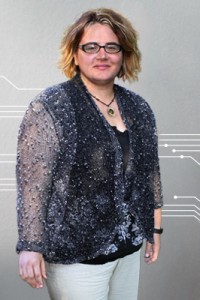Spotlight on: Francesca Myman

Francesca Myman is the design editor at Locus, where she has worked for 13 years. At Locus she’s been responsible for cover art and interior interview designs since 2011, as well as spot and ad graphics, convention coverage and photography, ad hoc interviews, event planning, and art book acquisitions and wrangling for the Recommended Reading List, and more. She is a Clarion West graduate and a graduate of Yale University, with two advanced degrees in English and creative writing from California College of the Arts and Hollins University, and her interests include SFnal non-fiction, poetry, cephalopods, and social justice.
How did you get your start as a science fiction illustrator?
I’m told I’ve been an artist from day one. Apparently my first word was “light.” I’m a little surprised it wasn’t “Ohhh, shiny,” but it’s pretty much the same thing. My mother was a collage artist and she’d sit at the coffee table for hours just dripping in National Geo and Vogue cutouts – quartz specimens and women and mountains… whatever called to her. She’d move them around till something caught her eye. To this day I still rely on unexpected juxtaposition to spark the creative process and try not to get too tight at the beginning. The ideal for me is that you’re doing something like fine art at all times, even for commercial projects.
I’m quite fortunate to have a job that enables me to do that. I’m not selling product, I’m responding directly to SF and fantasy fiction. And I love SF/F more than anything else in the world. Mom was responsible for that too – or rather her part-time librarian job was. I got hooked on Le Guin and Bradbury and Tamora Pierce and Patricia McKillip early. I cherish those elements of my job that lead me back to the things I’ve always cared most about: SF/F literature, the arts, and the people that love and create those things.

What’s it like to be the Locus design editor?
I’ve designed 96 Locus covers, all but three with original artwork, including this issue’s CatNet illustration for Naomi Kritzer’s interview! I was pretty excited to do a cat cover, we’ve never done one of those on my watch. I’ve been doing art all my life but there’s nothing like the crucible of a monthly deadline to get your tuchus in gear. The art director/artist relationship is essential in production environments, because there comes a point where you’re working that fast, you just can’t see the art anymore. There’s no down time to retrain your eye. You can play tricks with it, like flipping your canvas horizontally or viewing it in black and white, but there’s no substitute for having someone else take a look. That someone is Locus editor in chief Liza Groen Trombi, who is notable for having ordered me to move planets just several centimeters to the right or left. And fortunately, because I am a titan, I am absolutely able to oblige with any planet-moving required. We have a good time in the office, lots of giggling.
What artists have most influenced and inspired you?
I live and breathe the Pre-Raphaelites. Absolutely adore them from Rosetti to Sandys to Evelyn de Morgan. . . and it’s telling I have to say her full name while the last names of the male greats suffice. A lot of women’s art history is a process of retrieval and restitution. So much has been lost – generations and generations of women artists who simply never achieved widespread recognition. It matters so much who hangs onto and cares about your canvases, and gender and race play into that a great deal. I still have hope for our ability to salvage and sing the praises of these past masters, at the same time as we’re building on them for the future.
So yeah, the Pre-Raphaelites for sure. Art Nouveau. The Symbolists and their luminous works, and the Decadents: Moreau, Delville, Redon, von Stuck – and I think you can see a lot of the roots of modern fantasy and even horror art in them. Goya, Blake. And more modern conceptual artists like Binh Danh, Christina Bothwell, Beth Cavener Stichter, Jessica Joslin, Anne Siems. I traveled all the way to Norwich to see the massive feathered spirals of Kate MccGwire in situ in an old Briton castle. I do love representational art, but as with fiction I’m much less interested in mimesis. I wanna deal with dreams and monsters!
Also close to my heart: the Surrealists, in particular women surrealists like the impeccable Remedios Varo, Léonor Fini, or the disturbing Kay Sage. Meret Oppenheim, Kahlo. Bill Sienkiewicz, Julie Dillon, John Picacio, Omar Rayyan, Jody A. Lee, John Harris, Geneva Benton, Donato Giancola. I feel like the community of SF/F artists is growing stronger every day and I derive a lot of strength from that and from the relationships I’ve built there over the years. Feels like home.

What does your workflow look like? Any unusual techniques?
My technique varies drastically depending on the author whose work I’m addressing. My goal for Locus is to be versatile and provide great variety. I’ve done scanography, scratchboard, pencils, photo collage, and tons of digital painting. I play a lot with the “painting with pixels” aesthetic, taking my mother’s game up a notch and using thousands of fragments from NASA and other public domain sources to paint scenes. I’ve done a number of Locus covers using that technique and they’re probably my most popular, excepting the Le Guin portrait, which was done originally in pencils.
Most are spacescapes, but there was one lakeside scene using this technique to illustrate Ken Liu’s Silkpunk interview for the May 2015 Locus. That one made it into a museum! Obviously Ken was to blame – he really loved the art and connected with it. That’s always a good feeling, when an author feels “seen” by your work. He’s used it in a couple articles about Silkpunk since and it was in the “Worlds Beyond Here: The Expanding Universe of APA Science Fiction” exhibit at the Wing Luke Museum in Seattle.
Is there something about what you do that you’d like to tell our readers about?
I’d love to mention my newest project, a Patreon offering behind-the-scenes process takes, weird baroque decorating challenges, Photoshop tutorials, and most importantly, cat pictures. COVID-19 has created a huge financial crunch and like so many artists I’m scared I’ll have to leave my home. The Patreon is one way to turn it around and try to make it into a positive. It’s an extraordinary thing to have a job that allows me to do art, event planning, and general rabble-rousing, and get PAID for doing it! Now I’d like to do more art outside of traditional deadline constraints. You can find me at <www.patreon.com/mizfrancesca>.
This spotlight and more like it in the October 2020 issue of Locus.
 While you are here, please take a moment to support Locus with a one-time or recurring donation. We rely on reader donations to keep the magazine and site going, and would like to keep the site paywall free, but WE NEED YOUR FINANCIAL SUPPORT to continue quality coverage of the science fiction and fantasy field.
While you are here, please take a moment to support Locus with a one-time or recurring donation. We rely on reader donations to keep the magazine and site going, and would like to keep the site paywall free, but WE NEED YOUR FINANCIAL SUPPORT to continue quality coverage of the science fiction and fantasy field.
©Locus Magazine. Copyrighted material may not be republished without permission of LSFF.







